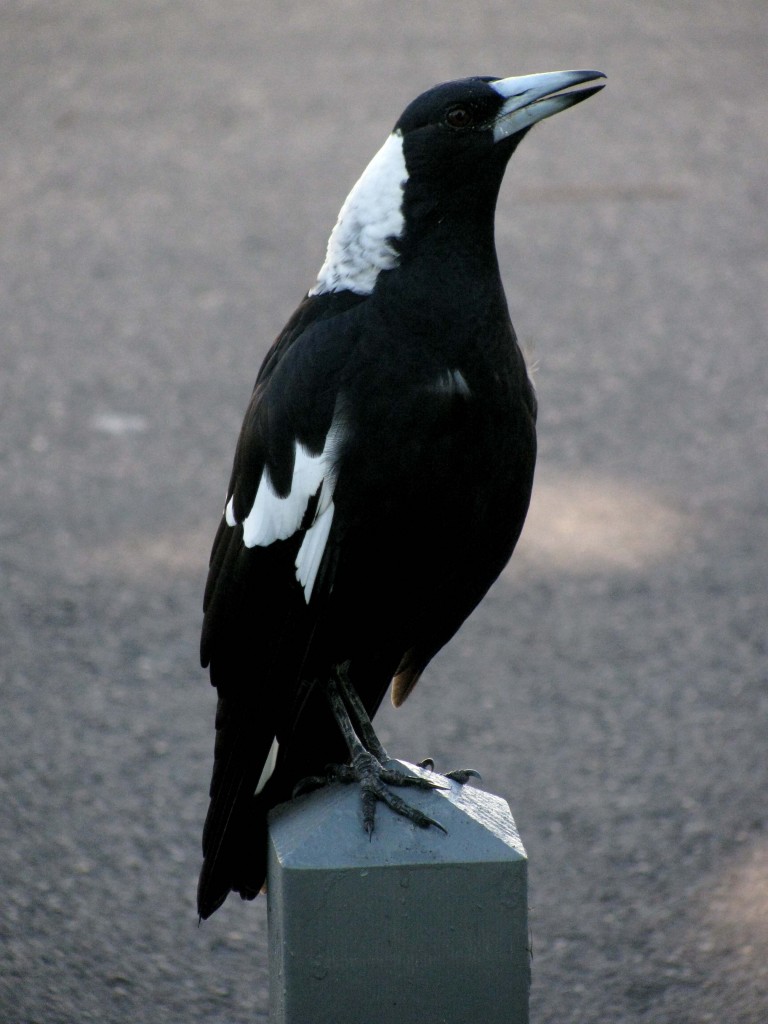Western Australia, Day 2

Australian Magpie Carolling (© Magi Nams)
Townsville: Cloud hung over the city, and cool winds buffeted the fronds of palms shading our yard. Beneath the palm canopies, my wee Aussie garden is gasping for sunshine. The leafy greens have died and the beans gone the way of young rainforest trees – tall, spindly, and with a low survival rate. Three remain alive and of those, one is blooming. Each day, the zucchinis further relinquish their hold on life, but the two tomatoes struggle on, as do the herbs and petunias. The last have already rewarded me with splashes of vivid pink atop stunted stems.
In late afternoon, I abandoned blog revisions to walk alongside the golf course and drink in the sounds of Australian magpies and other songbirds.
The territorial calls of the magpies, which I have referred to as yodelling are referred to by ornithologists as carolling.1 Carolling is performed by both males and females within a family group.2 One bird begins the carolling, and one or more others join in, with the second songster often the mate of the first.3 The function of carolling is to proclaim ownership of a territory,4 a space within which the magpies comprising a family group forage for food, perch in trees, build nests, and raise young.5 Magpies are sedentary, that is, remaining in the same area throughout their lives6, and may live to the age of 25 years.7
Two colour phases of magpies exist – white-backed and black-backed,8 and each individual magpie has a distinctive pattern of white patches on its closed wings.9 Every day, I see magpies listening and looking for food on the golf course lawns, and I’ve observed them carolling from power poles and the tops of trees and posts. My next challenge is to check out those closed winigs for the magpie equivalent of fingerprints.

Desert Truck with Kangaroo Grill and Flood Periscope (© Vilis Nams)
Western Australia: After flying from Perth to Leinster in early afternoon, Vilis and Janis, along with Dr. Euan Ritchie and his assistant Gus McNab, drove two rented 4×4 trucks to a cattle station called Yakabindi, the first biodiversity sampling site. After checking into the station’s field camp, they explored the station to determine where to sample vegetation and animal life.

Yakabindi Station Yard, with Irrigated Lawn (© Vilis Nams)
Yakabindi is owned by the BHP mining company, which purchased all the stations around its nearby mine to minimize complaints by pastoralists (ranchers). By law, the stations must be occupied, so the company runs cattle on the stations, but doesn’t have to earn profits from them. Money was much in evidence, as the fences were new and well-maintained, and all the station utes (Aussie pickups) were less than 5 years old.

Yakabindi Cattle Country (© Vilis Nams)
Red sand dominated the landscape, which was sparsely vegetated. The stocking density of cattle was very low, approximately 1 per 2.5 square kilometres. While checking out the station, the research crew spotted an Australian bustard among the shrubs and emus drinking from a puddle.

Emu (© Vilis Nams)

Australian Bustard (© Vilis Nams)
Yellow-spotted monitors and their trails were also common sightings.

Reference:
1. Gisela Kaplan. Australian Magpie: Biology and Behaviour of an Unusual Songbird. 2004. CSIRO PUBLISHING, Collingwood, Victoria. p. 37; 2. Ibid, p. 108; 3. Ibid, p. 37, 109; 4. Ibid, pp. 37-38; 5. Ibid, p. 35; 6. Ibid, p. 33; 7. Ibid, p. vii; 8. Ibid, p. 7-8; 9. Ibid, p. 61.


